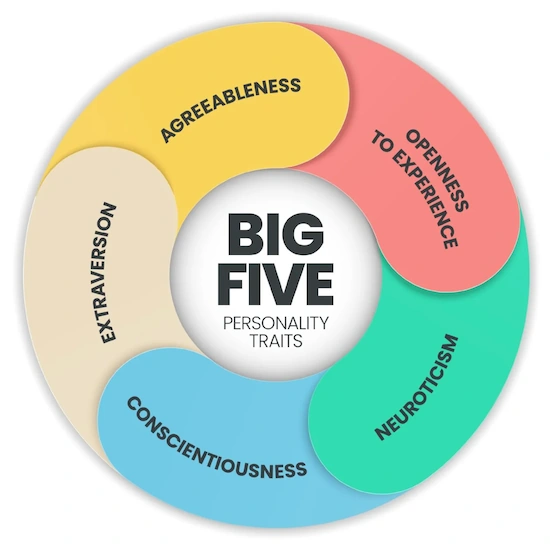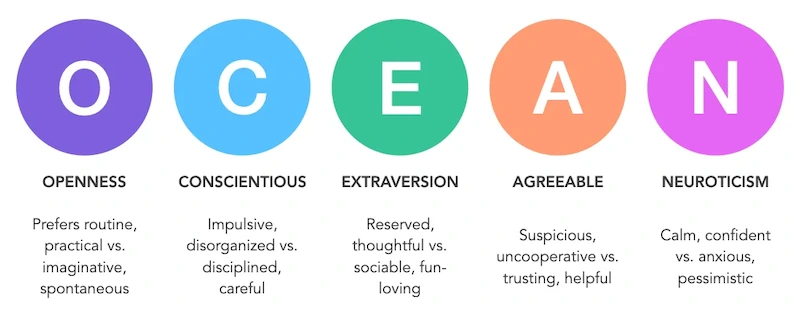
Theoretical Basis and Origins
The Big Five Personality Model, commonly referred to as OCEAN, is a psychological framework that categorizes human personality traits into five broad dimensions: Openness, Conscientiousness, Extraversion, Agreeableness, and Neuroticism. This model is rooted in trait theory, which posits that individual differences in personality can be quantified and measured through observable behaviors and self-reported assessments.
The origins of the Big Five can be traced back to the mid-20th century when researchers began to analyze language to identify descriptors of personality. One of the earliest contributors was psychologist Gordon Allport, who suggested that personality could be understood through a set of traits. However, it was Raymond Cattell who advanced this idea by employing factor analysis—a statistical method used to identify underlying relationships between variables—to reduce the number of personality traits into a more manageable set. Cattell initially identified 16 primary factors but acknowledged that these could be further distilled.
In the 1980s, psychologists Robert McCrae and Paul Costa conducted extensive research using factor analysis on various personality assessments. They synthesized their findings into what became known as the Five-Factor Model (FFM), which later evolved into the Big Five model. Their work demonstrated that five core dimensions could effectively describe human personality across different cultures and contexts. This model gained traction due to its empirical support and ease of application in both research and practical settings.
The Five Dimensions Explained
The Big Five traits represent a continuum where most individuals fall somewhere between the extremes of each dimension rather than fitting neatly into one category or another.
1. Openness to Experience
Openness to Experience is characterized by a person’s willingness to engage with novel ideas, experiences, and unconventional values. Individuals high in this trait tend to exhibit the following characteristics:
Imagination: They often have vivid imaginations and enjoy creative pursuits such as art, music, or writing.
Curiosity: High openness is associated with a strong desire for knowledge and exploration. These individuals are likely to seek out new experiences, whether through travel, learning new skills, or engaging in diverse cultural activities.
Flexibility: People who score high on openness are generally more adaptable to change and open-minded about different perspectives.
Intellectual Engagement: They tend to appreciate abstract thinking and theoretical concepts over concrete facts.
Conversely, individuals low in openness may prefer routine and familiarity. They might be more conservative in their beliefs and less inclined toward imaginative or creative endeavors. Such individuals often value tradition and may resist change or new ideas.
2. Conscientiousness
Conscientiousness reflects an individual’s degree of organization, dependability, and goal-directed behavior. Those who score high in conscientiousness typically display the following traits:
Self-discipline: Highly conscientious individuals possess strong self-control and can delay gratification to achieve long-term goals.
Dependability: They are reliable team members who follow through on commitments and responsibilities.
Attention to Detail: These individuals often pay close attention to details and strive for accuracy in their work.
Goal Orientation: Conscientious people set clear goals for themselves and work diligently towards achieving them.
On the other hand, those low in conscientiousness may exhibit spontaneity or carelessness. They might struggle with organization or time management, leading them to miss deadlines or overlook important details.
3. Extraversion
Extraversion is characterized by sociability, assertiveness, and a tendency toward positive emotionality. Individuals high in extraversion often exhibit the following behaviors:
Sociability: Extraverts thrive in social situations; they enjoy interacting with others and often seek out social gatherings.
Assertiveness: They tend to be confident in expressing their opinions and taking charge of situations.
Positive Emotions: Extraverts frequently experience feelings of joy and enthusiasm; they are generally more optimistic than introverts.
Energetic Engagement: These individuals often approach life with vigor; they may engage enthusiastically in activities that involve teamwork or collaboration.
In contrast, introverts—those who score low on extraversion—may prefer solitary activities or small groups over large social gatherings. They might feel drained after extensive social interactions and require time alone to recharge.
4. Agreeableness
Agreeableness reflects an individual’s tendency toward compassion versus antagonism in interpersonal relationships. People high in agreeableness typically demonstrate the following traits:
Empathy: Highly agreeable individuals are sensitive to others’ feelings; they can easily understand different perspectives.
Cooperation: They prioritize harmony within groups; agreeable people are often willing to compromise for the sake of maintaining relationships.
Trustworthiness: These individuals tend to trust others readily; they believe most people have good intentions.
Altruism: Agreeable people often engage in helping behaviors without expecting anything in return.
Conversely, those low in agreeableness may display competitiveness or even hostility towards others. They might prioritize their own needs over those of others and could be perceived as critical or confrontational.
5. Neuroticism
Neuroticism pertains to emotional stability versus instability. Individuals scoring high on neuroticism typically show the following characteristics:
Emotional Reactivity: Highly neurotic individuals experience intense emotions such as anxiety, sadness, anger, or irritability more frequently than those low on this trait.
Mood Swings: They may have difficulty regulating their emotions; mood fluctuations can occur rapidly based on external circumstances.
Sensitivity to Stressors: Neurotic individuals often perceive situations as threatening or overwhelming; they may struggle with stress management techniques.
Pessimism: Those high in neuroticism might have a tendency towards negative thinking patterns which can affect their overall outlook on life.
In contrast, individuals low on neuroticism tend to be emotionally stable; they handle stress well and maintain a calm demeanor even under pressure.

How It Works
The Big Five model operates on the premise that these five dimensions encompass a wide range of human behaviors and attitudes across various contexts—personal relationships, workplace dynamics, educational settings—and even cultural backgrounds. Each trait exists on a continuum rather than as binary categories; thus individuals can have varying degrees of each trait.
The Big Five Personality Test typically consists of a series of statements or questions that respondents evaluate based on their agreement or disagreement. These statements are often presented in a Likert scale format, where individuals rate their responses from 1 (strongly disagree) to 5 (strongly agree). The test may include anywhere from 40 to 100 items depending on the specific version being used.
Various psychometric tools have been developed based on this model for assessing personality traits quantitatively; one widely used assessment tool is the NEO Personality Inventory (NEO-PI-R). Developed by McCrae and Costa themselves, this inventory provides detailed insights into an individual’s standing on each of the five dimensions along with their facets—specific traits that contribute to broader categories (for example: facets under Conscientiousness include orderliness and achievement striving).
Additionally, researchers have validated the Big Five model through numerous studies demonstrating its reliability (consistency over time) and validity (accuracy in measuring what it claims). Cross-cultural studies have shown that these five dimensions appear consistently across diverse populations globally.
Limitations
While the Big Five Personality Test provides valuable insights into personality traits, it also has limitations. It relies heavily on self-reported data which requires individuals to have a degree of self-awareness for accurate responses. Respondents are asked to evaluate their own traits and behaviors, which can lead to biases. Individuals may overestimate or underestimate their characteristics due to lack of self-awareness, social desirability (the tendency to respond in a manner that will be viewed favorably by others), or even mood at the time of taking the test. This can result in inaccurate portrayals of one’s personality. Additionally, some critics argue that personality traits can vary significantly depending on situational factors rather than being fixed characteristics.
Practical Applications
The utility of the Big Five model spans multiple domains.
Psychological Research: It serves as a foundational framework for understanding personality psychology—enabling researchers to explore correlations between personality traits and various life outcomes such as academic success or relationship satisfaction.
Clinical Psychology: Clinicians use it for diagnosing mental health conditions or tailoring therapeutic approaches based on individual personalities; understanding a patient’s dominant traits can inform treatment strategies.
Workplace Settings: Organizations utilize assessments based on the Big Five for recruitment processes or team dynamics analysis since understanding employee personalities can enhance collaboration among team members while also guiding leadership styles suited for different personalities within teams.
Personal Development: Individuals can gain insights into their own behaviors through self-assessment tools based on OCEAN principles which can guide personal growth strategies, helping them identify strengths they wish to leverage further while recognizing areas needing improvement.
Bottom Line
In summary, the Big Five Personality Model provides a comprehensive framework for understanding human behavior through its five core dimensions—each contributing uniquely to our overall personality profile while offering valuable insights applicable across various fields including psychology research practices as well as everyday life scenarios involving interpersonal interactions.
Don’t forget to try our BIG FIVE PERSONALITY MINI-TEST

